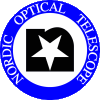70-005 The very early emission in relativistic supernovae at optical wavelengths
PI: Luca Izzo
Observing instructions:
Go to the directory
cd ~/scripts/70-005
execute the requested scripts.
| Program Tracking |
| Proposal |
70-005 |
| Semester |
P70: 20241001 - 20250401 |
| Principal Investigator |
Luca Izzo |
| Programme |
The very early emission in relativistic supernovae at optical wavelengths |
| Instrument |
ALFOSC |
| Time Allocation |
2 triggers, 3.5 hours in total per target spread over 4 epochs |
| Total Nights |
7h |
| Type |
ToO+SoftToO |
| Notes |
Override, but should aim for (soft) triggers during Nordic service or Technical nights |
| Total Time Spent |
03:28 (hh:mm)
|
| Proposal |
Date |
Time |
Type |
Targets |
Files |
Comments |
Status |
|
| 70-005 |
2024-11-27 |
00:10 |
SoftToO |
SN2024abup |
ALHk270241 - ALHk270245, ALHk270251 |
Observed in cloudy / dusty skies with high seeing
ALHk270251 is the standard star |
Observed |
|
| 70-005 |
2024-12-03 |
00:23 |
SoftToO |
SN2024abup |
ALHl030249 - ALHl030253 |
Target observed with clear skies and seeing around 3 arcsec. |
Observed |
|
| 70-005 |
2024-12-28 |
01:09 |
SoftToO |
SN2024acsd, SN2024adml, SN2024aecx |
ALHl280147 - ALHl280151, 155-159, 170-174 |
Bad seeing |
Observed |
|
| 70-005 |
2025-01-29 |
00:23 |
SoftToO |
SN2025iv |
ALIa290110 - ALIa290113 |
Observed with clear skies and variable seeing between 1.3" - 1.6" |
Observed |
|
| 70-005 |
2025-02-01 |
00:46 |
SoftToO |
SN2024iss |
ALIb010134 - ALIb010138 |
First exposure was aborted due to a sudden spike in humidity.
Target was later observed without problems. |
Observed |
|
| 70-005 |
2025-02-14 |
00:15 |
SoftToO |
SN2025oq |
ALIb140270 - ALIb140274 |
Observed. Partial thin cloud coverage at the start of the observation which cleared out. Seeing around 1''. |
Observed |
|
| 70-005 |
2025-02-26 |
00:22 |
SoftToO |
SN2025oq |
ALIb260227 - ALIb260231 |
Observed with clear skies and seeing around 1". |
Observed |
|
The above information is collected from the ToO/Mon reports that have been created by the observer.
Should any of the observations have been carried out using the OB system, you will find additional information
HERE
|
